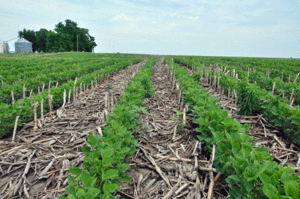Carbon farming

Carbon Farming is the use of farming techniques to return once released carbon in the form of carbon dioxide CO2 back to the Earth. By sequestering CO2 from the atmosphere and returning it to the earth, not only is the amount of CO2 removed resulting in a lower concentration of greenhouse gases, soil loss due to erosion decreases, soil fertility increases; animals and vegetation prefer higher CO2 and an overall increase in soil health and stability.[2]
Reasons for Carbon Farming
Due to the ever-increasing greenhouse gas emissions and today’s methods of farming such as tilling, grazing and the use of tractors and other diesel or gas machines, CO2 is released into the air. These practices degrade the soil releasing any stored CO2 and reducing the soil’s biological life. Before farming was a worldwide-implemented process, the average earth soil contained up to 20% CO2. Today, the average amount of CO2 found in soil is anywhere from 0.5-5%. However, spent soil has the capability to intake more carbon. By implementing carbon farming particularly in areas with spent soil such as the states, Australia and Africa, the soil could consume the amount of CO2 that is released by cars while also improving soil fertility and food production.[3]
Techniques to Carbon Farming
To remove the carbon in our atmosphere, one must change the way they go about their farming techniques. Proposed techniques include the implementation of compost layers, no-till farming, biochar use, higher controls on grazing and many other forms of land management to reduce greenhouse gases.[2]
- The addition of compost layers has huge impacts on converting a farm to a carbon farm. If one adds a cover of about a centimeter and half of compost to grazed land, the soil water holding capacity would increase to 26,000 liters per 10,000 square meters, this can increase the feed in the area by up to 70% and increases the amount of carbon intake by the soil by a minimum of 2000 pounds per 10,000 m2 per year. Done properly, the compost layer would not need to be reapplied for up to 30 years.[4]
- To reduce the amount of CO2 being released from the ground due to plowing and tilling, no-till farming is key. No-till farming is essentially removing any form of plowing or tilling from your farming techniques, planting through the leftovers of the preceding plants and weeds. This can be considered another form of compost layer as the old dying plants from the previous season overlay the area for the new plants.[5] Figure 1 above shows a fully operational farm that has implemented no-till farming.
- Biochar is essentially carbon-based charcoal from burnt plants and vegetation that have been subjected to anoxic environments. Biochar is found all over the world whether from previous forest fires or from human induced fires. It can be used as a safe and efficient fertilizer, once buried in the soil can aid with water retention, fertility and carbon sequestration.[6][3]
References
- ↑ L.Crowell, USDA. No-till Farming Critical for Preventing Loss of Soil Moisture During Drought Conditions [Online]. Available: http://www.nrcs.usda.gov/wps/portal/nrcs/detail/ia/home/?cid=nrcs142p2_011847
- ↑ 2.0 2.1 Carbon Farmers of Australia. What is Carbon Farming [Online]. Available: http://www.carbonfarmersofaustralia.com.au/About/what-is-carbon-farming
- ↑ 3.0 3.1 A. Bates, “The Biochar Solution, Carbon Farming and Climate Change,” New Society Publishers, National Library of Canada, 2010. ISBN: 978-0-86571-677-3. Chapter 15: Carbon Farming, pp. 75-81.
- ↑ Carbon Cycle Institute. Carbon Farming [Online]. Available: http://www.carboncycle.org/carbon-farming/
- ↑ Mother Earth News editors (1984, 06). No-Till Farming Pros and Cons [Online]. Available: http://www.motherearthnews.com/homesteading-and-livestock/no-till-farming-zmaz84zloeck.aspx
- ↑ International Biochar Initiative (2016). What is Biochar? [Online]. Available: http://www.biochar-international.org/biochar

